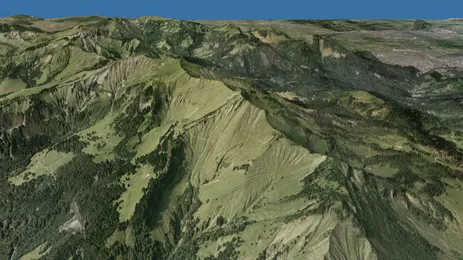Interactive Editing of GigaSample Terrain Fields
Marc Treib, Florian Reichl, Stefan Auer, Rüdiger Westermann
Technische Universität München, Germany
Background
Previous terrain rendering approaches have addressed the aspect of data compression and fast decoding for rendering, but applications where the terrain is repeatedly modified and needs to be buffered on disk have not been considered so far. Such applications require both decoding and encoding to be faster than disk transfer. We present a novel approach for editing gigasample terrain fields at interactive rates and high quality. To achieve high decoding and encoding throughput, we employ a compression scheme for height and pixel maps based on a sparse wavelet representation. On recent GPUs it can encode and decode up to 270 and 730 MPix/s of color data, respectively, at compression rates and quality superior to JPEG, and it achieves more than twice these rates for lossless height field compression. The construction and rendering of a height field triangulation is avoided by using GPU ray-casting directly on the regular grid underlying the compression scheme. We show the efficiency of our method for interactive editing and continuous level-of-detail rendering of terrain fields comprised of several hundreds of gigasamples.
A preprint of the article is available for download below; the definitive version is available at http://diglib.eg.org/.
The source code of our GPU compression library, written in C++ and CUDA, is available here. This does NOT include the terrain editing system, it only contains the compression code!
Note: A later version of the library with more features and improved performance was released with our Vis 2012 paper.
Acknowledgments
The authors wish to thank the Landesvermessungsamt Feldkirch, Austria, for providing the Vorarlberg data.
This publication is based on work supported by Award No. UK-C0020, made by King Abdullah University of Science and Technology (KAUST).
Associated publications
Interactive Editing of GigaSample Terrain Fields
M. Treib, F. Reichl, S. Auer, R. Westermann
Computer Graphics Forum 31(2):383-392 (Proc. Eurographics 2012)
doi:10.1111/j.1467-8659.2012.03017.x
[PDF] [Bibtex] [Code]

